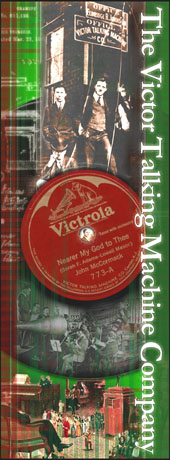 |

|
 |
|
 |
 |
The
Victor Talking Machine Company
Appendix X
License
Royalty
| 1. |
Victor started to license its
products for SALE as early as March I, 1902, barely
five months after the company was incorporated. The notice read as
follows:
NOTICE
This machine, which is
registered on our books No._______ is licensed by us for sale and use
only when sold to the public at a price not less than $ _______. No
license is granted to use this machine when sold at a less price. Any
sale or use of this machine when sold in violation of this
condition will he considered as an infringement of our United
States patents under which this machine, and records used in connection
therewith are constructed, and all parties so selling or using this
machine contrary to the terms of this license will be treated
as infringers of said patents, and will render themselves liable to
suit and damages.
The license is good only so
long as this label and the above noted registered number
remains upon the machine: any erasures, or removal, of this label will
be construed as a violation of the license. A purchase is an
acceptance of these conditions. All rights revert to the undersigned in
the event of any violation.
VICTOR TALKING MACHINE CO.
|
| 2. |
The plan was broadened and
made the basis of dealer and distributor franchising on June 1, 1906.
|
| 3. |
The basic plan of 1906 was
revised on May 1, 1910. The most important change called for exclusive
representation by the Distributors.
|
| 4. |
On August 1, 1913 the plan was
changed from a "License to Sell" basis to a "License to Use." The
exclusive representation provision was dropped.
|
| 5. |
This plan of sale, developed
by some of the best legal minds of the time, was based on the theory
that an inventor, having been given a patent monopoly by the
government, was entitled to control of its application during the
17-year life of the patent.
|
| 6. |
Victor’s objective
was to set up a fair schedule of prices for the public, for dealers,
and for distributors, and to keep price-cut scalping from making the
line unattractive and unprofitable to dealers who could and were ready
to do constructive jobs of merchandising.
|
| 7. |
In 1915, the United States
Circuit Court of Appeals for the second Circuit handed down a decision
favorable to the company.
|
| 8. |
However, on April 9th, 1917,
the United States Supreme Court rendered a decision to the effect that
the notices applied to the company product were “in part
unenforceable.” Whereupon, the company announced to the Trade
that the plan had been discontinued and that sales in the future would
be without control. Suggested prices were clearly marked “not
binding on the Trade.”
(p. 113)
|
|

